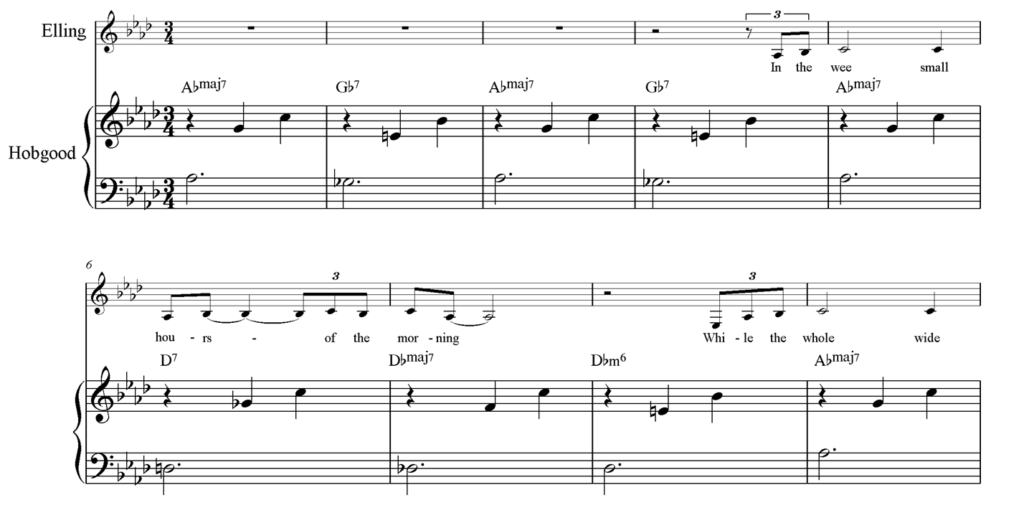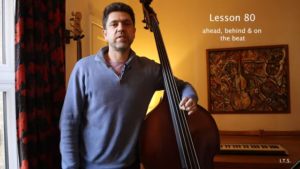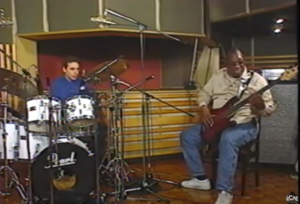CHAPTER 5: CREATING INTRODUCTIONS FOR THE VOCALIST(ボーカリストのためのイントロ作り)
The accompanist’s playing must not be tentative. If there is an introduction to the song he should deal with it in an authoritative manner.36 – Gerald Moore
伴奏者の演奏は、躊躇してはいけません。曲の冒頭がある場合は、自信を持って扱うべきです。ジェラルド・ムーア氏
A proper introduction establishes the key, style and tempo and sets the appropriate mood for the vocalist’s entrance. Even in the most complex of introductions, the vocalist’s starting pitch should never be left in doubt. Numerous conventions for introductions are used for both vocalists and instrumentalists. The use of a Imaj7-vi7-ii7- V7 turnaround (ie. Cmaj7, Am7, Dm7, G7 in the key of C major), the last four or eight measures of the song, a rhythmic vamp (I-V7), or some variant of these examples is common. A clear harmonic or melodic signal, such as ending the introduction on the V7 chord for songs beginning on the tonic chord, or making the top note of the final chord the starting pitch for the vocalist is also useful, but not always necessary, depending on the desired arrangement as well as the experience level of the vocalist. Accompanists achieve clarity in their introductions in a variety of ways, and their choices are often dependant on the style and tempo of each piece.
適切なイントロは、キー、スタイル、テンポを確立し、ボーカリストの入りに適したムードを設定します。最も複雑なイントロでも、ボーカリストの始める音程がわからないようにしてはいけません。ボーカリストや楽器奏者のために、数多くの慣習的なイントロがあります。Imaj7-vi7-ii7- V7のターンアラウンド(Cメジャーの場合、Cmaj7、Am7、Dm7、G7)、曲の最後の4小節または8小節、リズミカルなヴァンプ(I-V7)などが一般的です。曲の冒頭に応じたV7コードでイントロを終了する、または最後のコードの最高音をボーカリストの始める音程にするなど、明確な和声的または旋律的なシグナルも有用ですが、必ずしも必要ではありません。伴奏者は、曲のスタイルやテンポによって、イントロを明確にするために様々な方法を選択し、その選択はボーカリストの経験レベルによっても異なります。
In-tempo introductions on ballads(バラードのイン・テンポのイントロダクション)
When creating in-tempo introductions for the vocalist on ballads, the pianist must set the appropriate mood for the piece. In a successful introduction the mood of the accompaniment matches the intent of the lyrics and tone of the vocalist that follows. One effective device is to create a static vamp or rhythmic ostinato. Paul Smith chose this
approach for Ella Fitzgerald on “Angel Eyes” on The Intimate Ella. Over an E dominant pedal in the left hand Smith plays tension-filled chromatically descending triads, based on the melody itself in the right hand, setting a mood that presages the haunting lyrics that follow:
バラードにおいてボーカリストのためのイン・テンポのイントロダクションを作成する際、ピアニストは作品に適したムードを設定しなければなりません。成功したイントロダクションでは、伴奏のムードが続くボーカリストの意図やトーンに合わせていることが必要です。効果的な手法の一つは、静的なヴァンプまたはリズミックなオスティナートを作成することです。ポール・スミスは、「The Intimate Ella」に収録されたエラ・フィッツジェラルドの「Angel Eyes」に対してこのアプローチを選択しました。左手のEドミナント・ペダルの上で、メロディー自体に基づいた右手のテンションを帯びたクロマチックな下降トライアドを演奏し、続く物悲しい歌詞を予告するムードを設定しています。
Example 5.1. Paul Smith, “Angel Eyes” (Dennis/Brent, 1953), introduction.

Ella Fitzgerald / The Intimate Ella - Angel Eyes
Laurence Hobgood uses a similar ostinato-based technique on “In the Wee Small Hours.”37 Employing a transparent texture with single notes, he minimally implies a conventional harmonic progression on the first two measures of the song, Abmajor7 and Gb7, repeating it twice. The translucent quality fits the nocturnal, wistful lyrics of the song.38 It is simple and pure, almost resembling a children’s song, and could only be achieved, as Hobgood observes, by “understanding the nature of groove – to make something minimal like that work, you’ve got to be deeply invested in time science.” Hobgood acknowledges that this particular introduction evolved as a result of performing the song many times, from communicating with Elling about it as well as reflecting upon it and adding suggestions of his own.
ローレンス・ホブグッドは、「In the Wee Small Hours」でも同様のオスティナートを用いたテクニックを使用しています。彼は単音で透明なテクスチャを使い、曲の最初の2小節で従来の和声進行を最小限に示し、AbM7とGb7を2回繰り返します。その半透明の質感は、曲の夜の情緒や憂鬱な歌詞にマッチしています。この導入部分は単純で純粋で、子供の歌に似ており、ホブグッドは、「そんなにシンプルなものを機能させるためには、グルーブの性質を理解している必要がある。」と語っています。ホブグッドは、この特定のイントロダクションは、エリック・エリングとの共演で多くの回演奏し、彼と相談したり、自分自身のアイデアを加えたりすることで進化したと認めています。
Example 5.2. Laurence Hobgood, “In the Wee Small Hours of the Morning” (Mann/Hilliard, 1955), introduction.

Kurt Elling / Nightmoves - Leaving Again/In The Wee Small Hours 2:40-
David Newton maintains that introductions on ballads depend on the song. He will build up “a slight tension before the singer comes in, essentially drawing the listener in.” In his introduction to “In the Wee Small Hours” on The Tender Trap, Newton sets up Stacey Kent’s key by hinting at the opening phrase of the actual melody with an improvised melody and soft diatonic chords. This helps foretell the plaintive mood and melody of the song and creates a smooth transition from the introduction to the main melody.
デイビッド・ニュートンは、バラードのイントロは曲によって異なると主張しています。彼は「歌手が入る前に、聞き手を引き込むためにわずかな緊張感を築き上げる」と述べています。ニュートンは、ステイシー・ケントのキーを示すために「In the Wee Small Hours」のイントロで、実際のメロディのオープニングフレーズを暗示する即興のメロディと柔らかい調性の和音を使用します。これによって、曲の哀愁に満ちたムードやメロディが予兆され、イントロからメインメロディへのスムーズな移行が生み出されます。
Stacey Kent / In the Wee Small Hours
Another effective introduction for a piece in any tempo, but especially a ballad, is to reuse part of the song’s harmony, and add an original melody on top of it. For introductions Eric Gunnison often draws on harmonic, melodic and rhythmic material from the tune itself. Gunnison chose this method when setting up the ballad “Dear Ruby,” based on Thelonious Monk’s “Ruby My Dear,” for Carmen McRae on Carmen Sings Monk by starting four measures from the end on the song. Before McRae’s entrance, Gunnison played the harmony in tempo, adding his own melodic material which resembles the melodic contour of the original.
バラードの曲においては、曲自体のハーモニーやメロディ、リズムの要素を取り入れて、オリジナルのメロディを加えたイントロダクションを作成するのも効果的です。Eric Gunnisonは、しばしば曲自体からハーモニーやメロディ、リズムの素材を引用してイントロダクションを作成します。Gunnisonは、Thelonious Monkの「Ruby My Dear」を元にしたバラード「Dear Ruby」をCarmen McRaeが歌う「Carmen Sings Monk」のために、曲の終わりから4小節前から始める方法を選びました。McRaeの入り口前に、Gunnisonは曲のハーモニーをテンポよく演奏し、オリジナルの曲と似たメロディを加えました。
Carmen McRae / Carmen Sings Monk - Dear Ruby
Out-of-tempo introductions on ballads(アウト・オブ・テンポのバラードの導入部)
Out-of-tempo introductions pose particular challenges. The pianist must think more orchestrally when playing rubato, which opens up more creative harmonic and registral possibilities. One effective method is varying the register during the introduction before the vocalist enters. David Newton sometimes uses a technique of playing in the upper register and gradually descending into a lower register of the piano, creating the musical effect of tension and release. Newton uses this technique in his introduction before Stacey Kent enters on “What the World Needs Now” on The Boy Next Door. For Newton, having a progression like this is a basic part of musical language.39
アウト・オブ・テンポの導入部は特に難しい課題を提供します。ピアニストは、ルバート演奏で演奏する場合には、オーケストラのように考える必要があり、より創造的なハーモニーと音域の可能性が開かれます。効果的な方法の1つは、ボーカリストが入る前に導入部でレジスターを変化させることです。デイヴィッド・ニュートンは、しばしば上部レジスターで演奏を開始し、徐々にピアノの下部レジスターに降りていくテクニックを使用して、音楽的な効果の緊張と解放を作り出します。ニュートンは、「The Boy Next Door」の中でステイシー・ケントが入る前にこのテクニックを使用し、彼にとって、このような進行は音楽的な言語の基本的な部分です。
Stacey Kent / The Boy Next Door
Laurence Hobgood has also used this registral technique in several introductions for Kurt Elling, notably on “Too Young to Go Steady” and “Ev’ry Time We Say Goodbye” on This Time It’s Love. Hobgood acknowledges that he conceived these introductions from an orchestral rather than pianistic standpoint: “When you’re playing the piano you should be thinking beyond the piano. If I start high like that it’s because I’m thinking of violins, violas, flutes and clarinets.” This orchestral approach is an imaginative technique that allows the accompanist to experiment and create fresh voicings for the singer.
ローレンス・ホブグッドは、カート・エリングのいくつかのイントロダクションでこのレジストラル技法を使用しており、特に『This Time It's Love』の「Too Young to Go Steady」や「Ev'ry Time We Say Goodbye」で使用しています。Hobgoodは、これらのイントロダクションをピアニスティックな観点ではなく、オーケストラの観点から考えて創造したと認めています。「ピアノを弾くときは、ピアノを超えた考え方をすべきです。高音から始める理由は、バイオリン、ビオラ、フルート、クラリネットを考えているからです。」このオーケストラのアプローチは、伴奏者が実験し、歌手に新鮮なヴォイシングを作り出すことを可能にする想像力に富んだ技法です。
Kurt Elling / This Time It's Love - Too Young to Go Steady
Kurt Elling / This Time It's Love - Ev'ry Time We Say Goodbye
On Greta Matassa’s version of “Ruby” on All This and Heaven, Too, Randy Halbertstadt uses a similar registral technique in the introduction. He asserts that it is a useful compositional device for contrast, whether accompanying a vocalist or in any other playing situation. Christian Jacob uses this approach, too, at the start of “Smile” on On the Other Side, “I Think of You” on Dancing in the Dark and “Two For the Road” on I’m With the Band.
グレタ・マタッサの「All This and Heaven, Too」に収録されている「Ruby」のバージョンでは、ランディ・ハルバートスタットがイントロで似たようなレジストラルテクニックを使用しています。彼は、ボーカリストを伴奏する場合や他の演奏の状況でも、対比を生み出すための有用な作曲デバイスであると主張しています。クリスチャン・ジェイコブも、「On the Other Side」の「Smile」、「Dancing in the Dark」の「I Think of You」、「I'm With the Band」の「Two For the Road」の冒頭でこのアプローチを使用しています。
Greta Matassa / All This and Heaven - Ruby
The Tierney Sutton / On The Other Side - Smile
Tierney Sutton / Dancing In The Dark - I Think of You
Tierney Sutton / I'm With the Band - Two For the Road
Using harmonic material extracted from the first measure of the song as an introduction is another effective device for out-of-tempo introductions, as it was in in- tempo introductions. Accompanists commonly repeat the material once or a number of times until the vocalist’s entrance. On “If I Loved You” from I’m With the Band, Jacob plays the first two harmonies of the song, Gmaj7 to Gdim7, twice, yet each with the same texture of ascending arpeggiated chords. Jacob maintains this texture when Sutton enters in the fifth measure, successfully creating a seamless link between the introduction and the first A section.
曲の最初の小節から抽出した和声的素材を導入として使用することは、インテンポの導入と同様に、アウトオブテンポの導入にとっても効果的な手段です。伴奏者は通常、ヴォーカリストの入り口まで素材を1回または複数回繰り返します。『I'm With the Band』の「If I Loved You」では、ジェイコブは曲の最初の2つの和声、Gmaj7からGdim7を2回演奏します。それでも、各和声は上昇するアルペジオのコードの同じテクスチャで演奏されます。サットンが5小節目で入る時、ジェイコブはこのテクスチャを維持し、導入と最初のAセクションの間にシームレスなつながりを作り出しています。
Tierney Sutton / I'm With the Band - If I Loved You
Though introductions are often improvised, sometimes the vocalist feels most comfortable knowing how the tune will be set up each time. Newton recalls that Stacey Kent favored hearing the same introduction each time to “What Are You Doing The Rest of Your Life,” a piece with a challenging opening vocal line. An arranged passage provides a solid harmonic foundation and instills comfort in the vocalist.
イントロダクションはしばしば即興で行われますが、時にはボーカリストが曲が毎回どのように始まるか知りたいと感じる場合もあります。ニュートンは、高い難易度を持つオープニングのボーカルラインを持つ「What Are You Doing The Rest of Your Life」に対して、ステーシー・ケントが毎回同じイントロダクションを聞きたがっていたと回想しています。アレンジされたパッセージは、しっかりとした和声の基盤を提供し、ボーカリストに安心感を与えます。
Stacey Kent / The Lyric - What Are you Doing the Rest of Your Life?
Introductions on mid to up-tempo pieces(中~速い曲に対するイントロダクション)
When creating introductions on mid to up-tempo pieces, Halberstadt typically errs on the side of simplicity: “If the singer can hear their key and knows when to come in, that’s the main thing. So I’ll use boiler plate techniques like a I-V vamp, the last four bars of the song, or a I-VI-II-V progression, maybe with a V pedal underneath.”
中~速い曲に対するイントロダクションについては、ハルバースタットは通常、シンプルさを重視する傾向があると語っています。「歌手が自分のキーを聴き、いつ入るべきかを知っていることが一番重要です。だから、私はI-Vヴァンプ、曲の最後の4小節、あるいはI-VI-II-V進行を使うことがあります。Vのペダルを下につけることもあります。」
At recording sessions or rehearsals, introductions are often worked out ahead of time to provide a solid foundation for up-tempo pieces. On “Cheek to Cheek” on I’m With The Band, Christian Jacob uses the melody of the song as the basis for the introduction, creating a vamp that leads Sutton to the melody. Jacob places the starting notes G and F at the top of voicings on parallel major chords, Bb and Ab respectively. After two measures, Sutton enters by lightly scatting over the established harmonic vamp, eventually singing the melody as the vamp continues.
レコーディングセッションやリハーサルでは、速い曲に対するイントロダクションは事前に練り上げることがよくあります。ジェイコブは、「Cheek to Cheek」(I'm With The Band)のイントロダクションで、曲のメロディをベースに使用して、サットンがメロディに入るためのヴァンプを作り出しています。ジェイコブは、並列のメジャーコード、BbとAbの上に、開始音であるGとFを配置します。2小節後、サットンさんは確立されたハーモニック・ヴァンプの上に軽くスキャットを入れながら、やがてメロディを歌い始めます。
Tierney Sutton / I'm With The Band - Cheek to Cheek
A similar pedal point technique to Smith’s “Angel Eyes” introduction can be used on faster tempo introductions. On “Man in the Air” from Kurt Elling’s Man in the Air, for example, Hobgood uses a single-note repeated figure in the left hand before employing various triads and four-note chords in the right hand to build tension before Elling enters.
中速から速いテンポの楽曲に対するイントロダクションでも、スミスが「Angel Eyes」のイントロダクションで使用したようなペダルトーンのテクニックを使用することができます。例えば、カート・エリングの「Man in the Air」の曲では、ホブグッドが左手で単音を繰り返し、エリングが入る前に右手でさまざまな三和音や四音和音を使用して緊張感を高めています。
Ella Fitzgerald / The Intimate Ella - Angel Eyes
Kurt Elling / Man in the Air - Man in the Air
Regardless the choice of technique, assistance from the accompanist is beneficial and often essential because vocalists do not have the visual reference points available to instrumentalists, such as keys or strings to aid in starting pitches. An appropriate introduction instills security in the vocalist and ensures trust between the vocalist and pianist.
どのような技法を選んでも、伴奏者からの支援は役立ち、しばしば不可欠です。歌手には、音高を始めるためのキーまたは弦などの視覚的な参照点が利用できないため、適切なイントロダクションは歌手に安心感を与え、歌手とピアニストの信頼関係を確保します。

